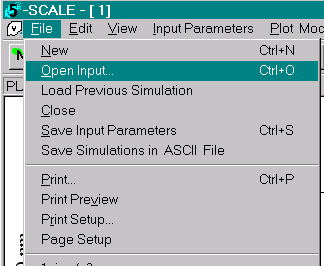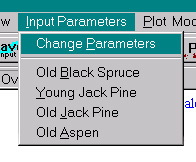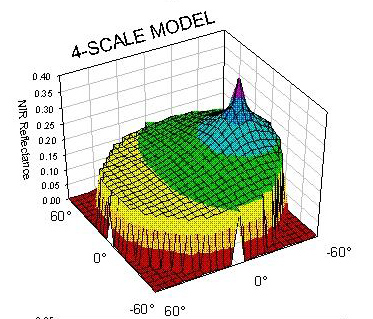

| 6- HOW TO SET THE PARAMETERS |
|
|
| Click here for command
line version (Unix/DOS)
Windows 95/NT version: Menu |
| Toolbar: |
| The parameters can be changed by
1) either opening an input file under the File menu: |
 |
| 2) using the button |
| or 3) by changing the values in the dialog box "Input Parameters". |
| The dialog box can be accessed from the Input Parameters menu: |
 |
| or by clicking the button |
| The model also has 4 defaults setting corresponding to 4 BOREAS southern study sites: Old Black Spruce, Young Jack Pine, Old Jack Pine, and Old Aspen. |
| The Input Parameters dialog box looks like this: |

By pressing ![]() you will get the rest of the parameters:
you will get the rest of the parameters:

The Parameters:
| Domain (Pixel): |
| Size: we suggest 10000 m2 for generic cases where the shaded proportions cannot be distinguished from the sunlit ones. Be careful when changing the size of the domain, the number of quadrats may need to be adjusted (see simple mode) |
| Number of stem: Enter the number of trees you have in the domain area |
| Tree Clumping: |
| Number of Quadrats: Divides the domain (pixel) into smaller area (quadrat). It also represents the maximum extend of a cluster of trees. You should be careful to make sure that the mean number of trees in a quadrat is less than about 200 (for computational reason). See Figs. 2 and 3 in [1] to understand the limitations of the model. The model should give you an error message if you choose too large or too small quadrats. Use the simple mode for an automatic calculation of the number of quadrats. Because of the elongation of the shadows with solar zenith angle, the size of the quadrat may need to be large enough to consider this, but has not been tested. |
| Neyman grouping:
Factor that distributes the trees in clusters. It is a double Poisson distribution process. Choosing "0" will produce the random case using the Poisson distribution. If you don't know what factor to use, we suggest a small number like 2 or 3. |
| Half Apex Angle a |
| Angle of the cone part of the conifers. Can be estimated from photographs. |
 |
| Without Branch Architecture |
| The clumping index WE |
| It is the value measured in the forest
stand (e.g., with TRAC). The model assumes that half of the forest clumping
is due to having foliage in crowns, so the value used in equation (22)
[1]
is computed as WE
(in model) = WE
(input) + (1 - WE
(input)))/2.
When using
the branch architecture,
WE
is implicitly computed ( its value cannot be changed in the parameters
dialog box of the Windows 95/NT version). Typical range: Grassland: 0.8-1.0
Deciduous: 0.6-0.9 Conifers: 0.5-0.8 |
| Projection of unit leaf area G(q) |
| When not known, G(q)
= 0.5 representing the random case is a good approximation for most canopies.
Measurements of different canopies [12]
show that G(q)
is
usually close to 0.5.
Empirical values for Douglas Fir stands [17]: G(q)
= 0.54 + 0.33q
for q <
48.7° (0.85 radian)
When using the branch architecture, G(q) is automatically computed by 5-Scale. |
| Branch Architecture |
| Detail in Leblanc
et
al., 1999
You will need to enter the branch architecture parameters in the "more" section of the dialog. |
 |
Branch inclination
ab
Angle at which the branches are oriented from the horizontal. Leaf orientation aL Angle at which the foliage (leaves or shoots) is orientated from the horizontal. Branch thickness: (in meters) Ratio thickness/width for leaf: Important for conifers where the shoot is the foliage element since it has a thickness more important than a flat leaf. Branch area index: typical 0.8-0.9 |
| Ws |
| The typical element projection inside the crown (in metre). This parameter is used by the hotspot kernel. |
| Typical values:
Black Spruce: 0.03-0.04 m Jack Pine: 0.05 -0.17 m (0.05 represents the shoots size, 0.17 represents the branches size) Aspen: 0.02 - 0.10 m Red Pine: 0.10-0.15 m White Pine 0.05 m |
| LAI |
| The leaf area index of the canopy, defined
as one half of the total foliage surface [9]
per unit of ground surface.
Note that instruments like the LAI-2000 measure the effective LAI (Le).
LAI = LegE /WE There is no typical values given for LAI, but remember that the LAI is distributed in the number of trees you have. Adding trees will diminish the foliage density in each crown. |
| The woody material is not considered in this version of the model. |
| ANGLES: |
| Solar zenith angle (qsor SZA) the model can handle SZA 0-80o |
| Azimuth difference
angle f:
0o-360o
, but 360o to 180o
is actually computed with 0o to 180o
since symmetry is assumed
(i.e.,f = 1ois the same as f=359o ) |
| VIEW ZENITH ANGLE
(qvor
VZA)
RANGE
The model is valid up to qv = 80o. Reflectance values can be computed for qv larger than 80o, but with less accuracy. The branch architecture is not giving a valid output at VZA=90o. |
| VZA MAX is the maximum VZA of the plane. |
| PLOT STYLE output. |
| PLANE |
| Note that VZA = 0 is done twice (One with each f). The output has negative VZA corresponds to backscatering. |
| USER DEFINED |
| This option allows the user to vary different parameters (e.g., NDVI versus LAI, Individual bands versus SZA). |
| Example of User Defined file: SUN.UD3 |
| HEMISPHERICAL |
| Used to reproduce '3D' plots like this: |
 |
| This figure was produced with Sigma Plot by SPSS. |
| HYPERSPECTRAL |
| Used for hyperspectral reflectance at specific view and solar angles. |
| Other parameters in .fs* files:
N_PHI 2 means that the next 2 lines contain
phi angles.
|
| Note that even when a values is not used, a default value needs to be in the file. |
|
RUNNING 5-SCALE: 1) Enter the parameters (e.g., with the dialog
box)
if "Cancel" is pressed, you get:  |